James Hetfield, Lars Ulrich, Cliff Burton and Kirk Hammett were in their early twenties when they released Master of Puppets. I first heard the album when I was in my mid-teens, while an aging Metallica seemed to be dedicated to their death’s construction – floundering somewhere between the misfire that was ReLoad and the erm, misfire (with an orchestra) that was S&M. But present disappointments didn’t matter to me and countless other acne-encrusted sweaty metallers born a decade too late. Master of Puppets mattered.
Back in 1986, Master of Puppets was just another giant leap for a confident, rapidly maturing band. The Kill ‘Em All ‘no life ’til leather’ posturing, fun though it had been, was long over. Metallica were still ‘metal up your ass’ in spirit, but musically they were trying to do something more sophisticated. Speedy thrash remained at the epicentre of their sound, but 1984’s Ride the Lightning had sent the band in a new direction: epic structures, expanded instrumentation (acoustic guitar!) and a broader lyrical approach, tackling topics ranging from capital punishment to the ten plagues of Egypt. Master of Puppets continued in the same vein, offering up eight musically complex tracks that dealt with themes such as mental illness, war’s ‘disposable heroes’ and drugs.
Addiction lies at the heart of the title track – the greatest song on Metallica’s greatest album. From the symphonic staccato intro to the menacing (ok, utterly cheesy) laugh of the outro, ‘Master of Puppets’ ranks as one of metal’s finest moments. It’s amongst the band’s fastest songs, but it’s also one of the longest. Over the course of a colossal 8 minutes and 38 seconds, the song shifts between enough riffs, interludes and solos to make up a classic album in its own right. Other masterstrokes include unrelenting opener ‘Battery’ and ‘Welcome Home (Sanitarium)’, a rapidly accelerating journey from subdued melancholy to thrashy delirium.
As it happened, 1986 turned out to be something of a watershed for the band. Six months after Master of Puppets was released, the band’s tour bus crashed – bringing the life of bassist Cliff Burton to an untimely end. Tracks like Kill ‘Em All‘s ‘Anesthesia (Pulling Teeth)’ and the intro to Ride the Lightning‘s ‘For Whom the Bell Tolls’ had already showcased Burton’s legendary ‘lead bass’ approach. On Master of Puppets he became even more experimental, most obviously on the eerie intro of unabashed thrasher ‘Damage, Inc.’ and the bass-dominated instrumental ‘Orion’. But throughout the rest of the album the low-end is mixed blissfully loud. Listen back now, and it’s hard not to appreciate the essential part he played in Metallica’s greatest hour.
Master of Puppets producer Flemming Rasmussen continued to work with the band for their 1988 follow up …And Justice for All. On the eve of that album’s release, Hetfield and Ulrich spoke to Richard Gehr (in an interview reproduced by the Quietus). "When is the bass too loud?" Ulrich asks rhetorically, to which both bandmates chorus: "When you can hear it!" So it was that Burton replacement Jason Newsted was drowned out by two of metal’s biggest egos, his bass turned down so low that its absence is almost deafening. Rumours of a remixed …And Justice for All have been quashed by Ulrich, but perhaps someone will take it upon themselves: thanks to Metallica’s involvement in the Guitar Hero / Rock Band plastic guitar industry, many of Newsted’s isolated bassline recordings from the album have been ripped and uploaded to YouTube.
After …And Justice for All came Metallica’s self-titled ‘Black Album’, in which things turned away from thrash and toward Bob Rock produced stadium-filling hard rock. There followed a period of steady and seemingly terminal decline, culminating in the horrifying yet strangely compelling car crash that was St. Anger (best served alongside band-in-decline documentary Some Kind of Monster). Something seemed to resuscitate the old beast though, and Metallica came back with Death Magnetic, an album that revived the epic, fast and heavy spirit of old.
1986 was an exceptionally good year for thrash albums: Metallica’s Master of Puppets, Slayer’s Reign in Blood, and Megadeth’s Peace Sells… But Who’s Buying? Since 2010, all three groups have been taking to the stage alongside Anthrax as part of the ‘Big Four’ tour. After years of on-off acrimony on both sides, it’s nice to see that Megadeth mainman Dave Mustaine – ousted from Metallica way back before they’d even released an album – is even able to share a stage with his former band. During an infamous ‘band therapy’ session with Ulrich filmed for Some Kind of Monster, Mustaine blamed his split with Metallica for ruining the past twenty years of his life: "Am I happy being number two? No."
In a few months Megadeth will be releasing a 25th anniversary version of Peace Sells, and guess who will be contributing to the liner notes? None other than one Lars Ulrich. Whether 2011 will see Mustaine singing the praises of his ex-bandmates’ finest hour remains to be seen.
First published on May 4, 2011


